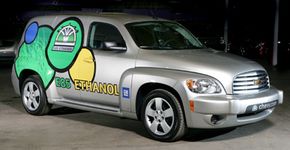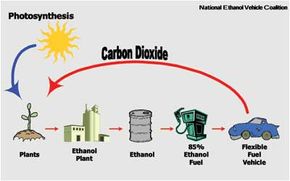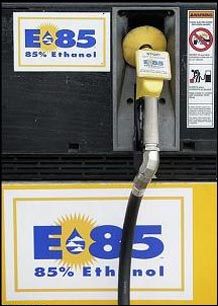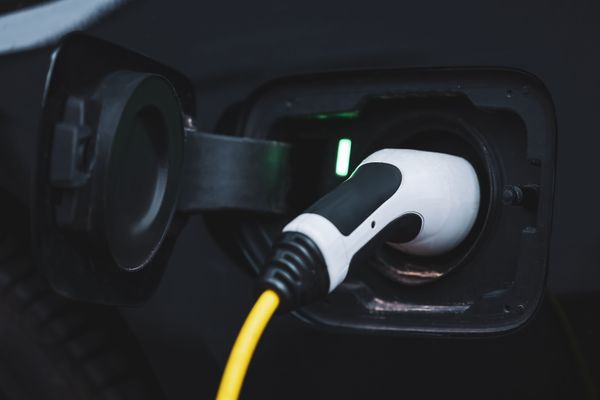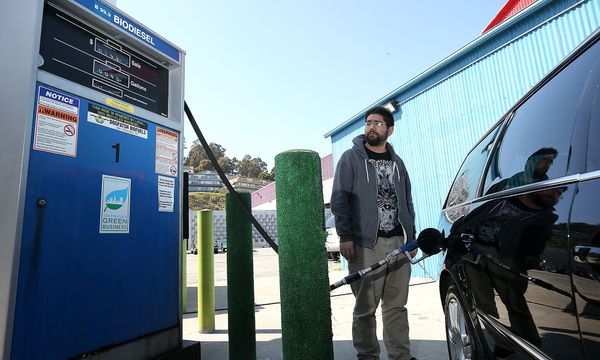Drivers jumping on the latest gas-saving bandwagon may be in for a shock when they see fuel-economy estimates for the newest darlings of Detroit: E85 ethanol flex-fuel vehicles. Run a new V6 Chevrolet Impala on good-old gasoline, and it'll get 21 miles per gallon in the city, 31 on the highway, according to Environmental Protection Agency (EPA) estimates. Burn E85 -- a blend of 85 percent of the alcohol-based fuel ethanol and 15 percent gasoline, which American automakers flaunt as their latest alternative-energy idea -- and the Impala's EPA numbers shrivel to 16 mpg city, 23 highway.
Alternative Fuel Vehicle Image Gallery
Advertisement
It's no better with other kinds of flex-fuel vehicles, vehicles that can run on E85, 100 percent gasoline, or a combination of the two. Run a two wheel-drive V8 Ford F150 on regular unleaded gas, and the EPA says it'll get 14 mpg city, 19 mpg highway. Run it on E85 ethanol, and it gets 11 mpg city, 14 mpg highway. In other words, fill up on environmentally friendly E85 ethanol, and you'll get fewer miles per gallon than you would on gasoline.
Sound depressing? Not if you believe that what's bad for the E85 ethanol user is good for America's fuel strategy. After all, a mile driven on E85 ethanol fuel is a mile not driven on conventional gasoline. And that, according to President Bush and proponents of E85 ethanol, can help America end its dependence on foreign oil.
Joining these E85 ethanol boosters are General Motors and Ford, which have mounted massive new E85 ethanol support programs. Spurred by public and private efforts to pump up E85 ethanol demand, ethanol producers themselves are pouring billions of dollars into building new refineries.
As with any alternative-fuel idea, however, the E85 ethanol story is one of tradeoffs. It pits, for example, E85 ethanol's ability to lower air pollution because it burns cleaner than gasoline against the potential environmental costs involved in ethanol production.
We've highlighted some tradeoffs in E85 ethanol fuel economy (more about that later), but are there compromises in convenience and vehicle performance? These and other issues are thoroughly explored in the following sections:
- E85 Ethanol Flex Fuel Explained About one-third of all gasoline sold in the United States contains some ethanol, typically in a ratio of 90 percent gasoline and 10 percent ethanol. E85 gets its name from the way it inverts that formula, at 85 percent ethanol and 15 percent conventional gasoline. We'll explain how ethanol is produced and why it's mixed with gasoline, and explore some of the controversy surrounding its place in environmental and public policy debates. Only a fraction of the cars and trucks on the road are "flex fuel" vehicles: those that can run on conventional gasoline or E85 ethanol fuel. You'll learn why that number is growing, and how you can determine whether your next new car or truck -- or maybe the one you already own -- is an E85 ethanol flex-fuel vehicle.
- How Does E85 Ethanol Affect You? E85 ethanol flex-fuel vehicles have some special technology in them. We'll explain how that may affect their purchase and maintenance costs. The automakers say running a flex-fuel vehicle on E85 has no effect on performance. We'll share our real-world experiences to find out if that's true. And although the number of gas stations selling E85 ethanol fuel is growing, we'll explain why there are still so few of them, and why they are clustered in a few geographic areas. Finally, how does using E85 ethanol fuel affect your pocketbook? And should that be the determining factor in whether you decide to use it?
